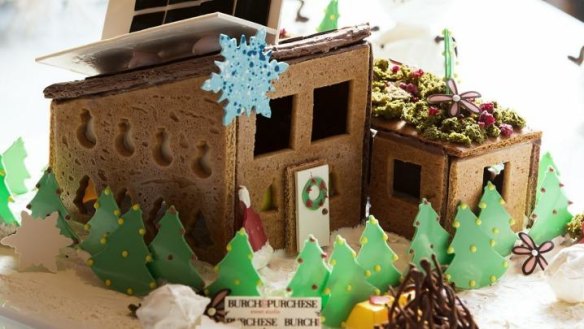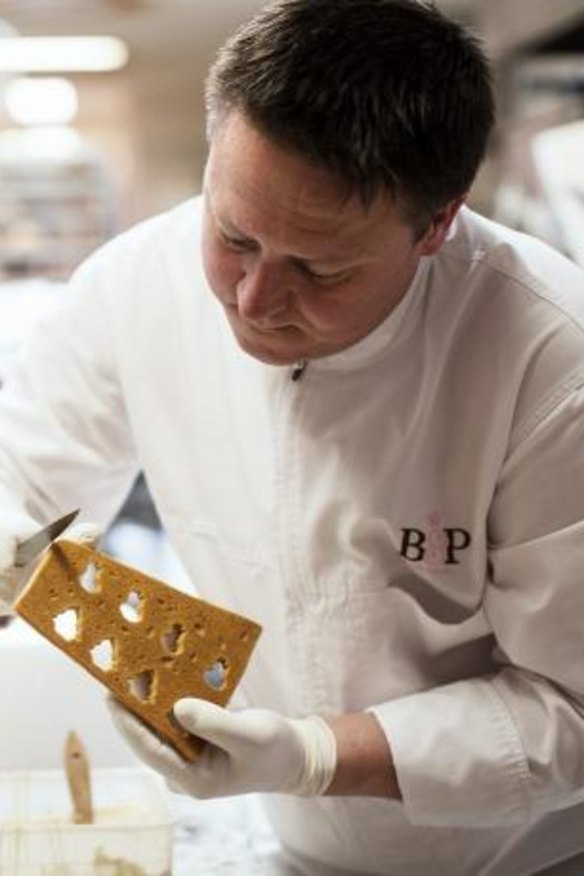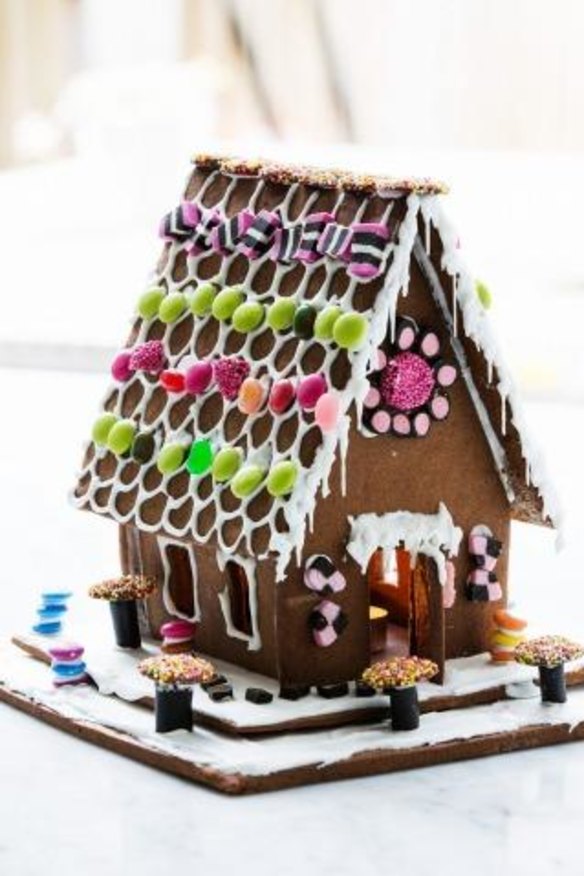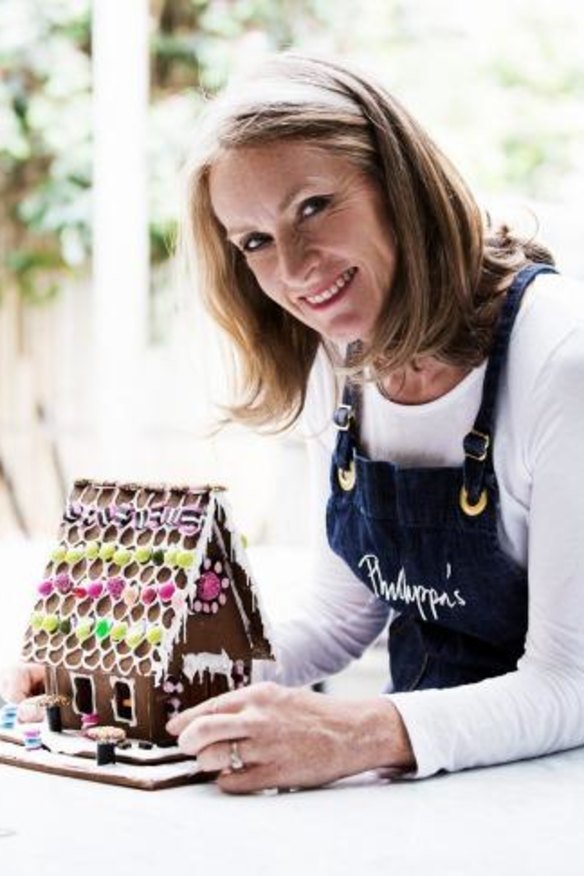How to make a Christmas gingerbread house
Darren Purchese's modern gingerbread house
Use your imagination to design your ultimate gingerbread dwelling. I have designed a modern house with chocolate solar panels and a green tea sponge-cake rooftop kitchen garden (hopefully Joost Bakker would approve). Architect Peter Maddison might have something to say about the lack of a second storey inside but I enjoyed the creative process and found it challenging yet therapeutic.
First, I designed the house using cardboard pieces and Blu Tack. Once they had been cut, measured and numbered, I used them as templates, and cut the same pieces from my rolled and rested gingerbread dough. I used a mix of gingerbread and chocolate gingerbread. The main walls are supported by white chocolate, painted on a cake board to look like snow, and I used mainly tempered chocolate for support and garnish, as it's a great alternative to classic icing.

Don't overlook home-made marshmallows and jellies when deciding on items to "pimp" your house. Use your imagination and sense of fun to live the Aussie dream of creating your own house.
Gingerbread (house dough)
1.6kg plain flour
1 heaped tbsp ginger powder
2 tsp bicarbonate of soda
salt
2 cups honey
420g sugar
75ml water
3 eggs
90ml full-cream milk
500g white chocolate and 150g dark chocolate for decorating

*For chocolate gingerbread dough, replace 10 per cent of the flour with good quality cocoa powder
Green tea micro sponge
8 egg whites
60g castor sugar
60g almond meal
20g plain flour
1 tbsp plain yoghurt (Greek-style works well)
1 heaped tbsp green tea powder
1. Sift the flour with the ginger powder and bicarb of soda into a bowl and add a pinch of salt.

2. Bring the honey, sugar and water to the boil and leave to cool. When cool, mix in the eggs (by hand or in an electric mixer on low speed) for five minutes.
3. Combine the dry ingredients (flour, ginger powder, bicarb of soda and salt) with the wet mixture and rest in the fridge for about 20 minutes, until cold. Mix the cooled mixture on a low speed for five minutes, then add
the milk.
4. Chill, then roll out the dough to about five millimetres thick then chill again for 15 to 20 minutes.

5. Using the cardboard templates and a sharp knife, cut the dough into panels, windows and decorative pieces, and label the dough with numbers. (Tip: Lay the dough panels on to a tray lined with baking paper and use a marking pen to write a number beside each panel.) Return these to the fridge and chill for a further 10 to 20 minutes.
6. Bake at 180C for 12 minutes. While the gingerbread is still warm, trim any rough edges with a sharp knife.
7. For the green tea micro sponge, place all the ingredients into a blender (or use a hand blender) and blitz
well until smooth.
8. Once the mixture is smooth, pour it into a cream whipper (a siphon gun) and charge with three nitrous oxide bulbs (don't use the soda chargers, nitrous gives volume and that's what you want). Shake the cream gun vigorously between each charge. (Tip: Essential Ingredient stocks half-litre cream whippers for $158, packet of bulbs $8.50.)
9. Rest the siphon in the fridge for 15 minutes.
10. Cut three slits into the bottom of 12 plastic disposable cups to vent the air (don't grease the cups, you want the mixture to grip to the sides) and discharge the mix into the prepared plastic cups to half-fill.
11. Cook for 45 seconds in the microwave.
12. Remove from the microwave and allow to cool in the cup for five minutes, then use a sharp knife to extract the sponge.
Assembly
Use a paintbrush to liberally paint or dab the cake board or serving tray with tempered white chocolate to look
like snow. For a cheat's way to temper chocolate, melt chocolate in short, high, 30-second bursts in the
microwave so it's a thick, melted mixture, not too runny. Use it to fix the walls of the house to the board and
to stick the walls and roof together. Hold the pieces until the chocolate sets.
Add chocolate panels for solar power.
Tear off irregular pieces of green tea sponge to create the rooftop kitchen garden.
Finish decorating to your own design.
Phillippa Grogan's traditional gingerbread house
Over 1000 years ago, folk believed gingerbread was introduced to Europe by a travelling Armenian monk who arrived in France and shared his recipe with the local religious community.
This early version was made using breadcrumbs, spices and honey and stirred, much like quince paste, on the top of the stove. It was more akin to a sweetmeat and similar to Spanish membrillo, which is pressed into a loaf tin, then cut and served. An intriguing but delicious version of this original gingerbread can be found in my
book Phillippa's Home Baking, written with Good Food columnist Richard Cornish.
Many other versions of gingerbread have come into existence over the centuries, including cakes, bread-like pain d'epices loaves that are served buttered, and soft or hard biscuits, which are sometimes coated with chocolate or a thin layer of baked-on icing. The mixture is sweetened with honey, golden syrup, treacle or molasses and always has spices, usually cinnamon or ginger but also pepper, allspice, clove and cardamom.
Making a gingerbread house is about design and construction. Your own design can be mocked up using cardboard and from this a template can be produced. Tip: Search online for a template.
The main points to remember are that gingerbread needs to be well cooked and evenly rolled. Pieces need to be cut accurately, preferably with straight lines, to ensure it fits together well. If necessary, the baked pieces
can be neatened with a knife after baking while still warm to exactly fit the original template as the dough
often spreads as it bakes.
Be generous with the icing because this is the glue. Doors and windows can be cut out before baking or while
still warm from the oven. They can also simply be "drawn" on with piped icing.
Humid weather may make the gingerbread go soft. Once complete, wrap the gingerbread house in cellophane to protect it.
The royal icing will set hard but needs to be held in place while drying with fingers or cans or jars of food.
Leave it to dry properly overnight before moving.
Phillippa Grogan's gingerbread
Based on the recipe from Phillippa's Home Baking, this will make enough dough for a house and a gingerbread base or some extra biscuits.
240g butter
200g castor sugar
4 egg yolks
2 heaped tbsp golden syrup
560g plain flour
2 tsp baking powder
1 tsp bicarbonate of soda
2 tsp ground ginger
4 tsp ground cinnamon
1 tsp salt
square 20x20cm silver cake board, optional
lollies to decorate – I use English licorice allsorts, mini jelly beans, Smarties, licorice fruit rockies, freckles
boiled lollies, preferably red and green for a stained-glass window (optional; see video)
Icing
2 egg whites
400g icing sugar
2 tbsp lemon juice
1. In a large bowl cream the butter and sugar until pale and creamy but not fluffy. Add the egg yolks and golden syrup and mix well.
2. In another bowl, blend together the dry ingredients. Add this to the butter mixture and mix well with a wooden spoon until it forms a uniform dough. Roll into a ball, cover with plastic film and allow to rest for at least
one hour.
3. Preheat the oven to 170C (150C fan-forced). Line a baking tray with baking paper.
4. Place the ball of dough on a lightly floured bench and, using a lightly floured rolling pin, roll out the dough into four to five-millimetre thickness. Place the template pieces as close together as possible so as not
to waste any of this first rolling of the dough. Using a knife, carefully and evenly cut out six pieces; two roof pieces, two side walls and a front and back wall. A 22-centimetre square piece can also be cut to use as a base. The dough may need to be rerolled for this. Be careful not to use too much flour.
5. Bake for about 25 minutes or until the gingerbread darkens and starts to colour at the edges. If necessary,
neaten edges with a large sharp knife while still warm. Windows and doors can also be cut out now, then allow the gingerbread to cool completely on a wire rack.
6. To make the icing, whisk or hand-beat the egg white until it forms soft peaks. Gradually sift in the icing
sugar and then slowly add the lemon juice. Place the icing into a piping bag with a fine nozzle or make a bag
using a square of baking paper.
7. To assemble, start with the four walls by piping a decent amount of icing along the vertical edges of the side walls. Stick these to the front and back walls, pressing together firmly. Use tins or jars to hold these in
place. Leave this untouched for an hour, or longer.
8. When the icing has set, pipe more along the angled edges of the front and back wall, and along the top of the side walls. Place the two roof pieces on so they are just touching along the top. Gently press these together and find some items to hold the roof pieces in place. Leave this for at least an hour.
9. When this structure is dry, it is safe to lift on to a square silver cake board or your gingerbread base. If you're using a gingerbread base, cover this with icing and then gently place the house in the centre. Otherwise pipe some icing on the cake board to stick the house in place.
10. The decoration can now begin. First, separate your lollies into colours. This will make it easier to create a colour scheme. Use a small amount of icing to adhere lollies to the gingerbread, holding in place for a few seconds if necessary. Pipe around windows and doors. A row of freckles can cover the roof join. Pipe half loops in rows on the roof to form tiles. Icicles can be piped on; see video.
Appears in these collections
The best recipes from Australia's leading chefs straight to your inbox.
Sign up